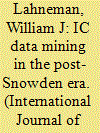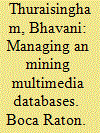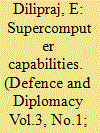|
|
|
Sort Order |
|
|
|
Items / Page
|
|
|
|
|
|
|
| Srl | Item |
| 1 |
ID:
059631


|
|
|
|
|
| Publication |
London, Idea Group Publication, 2001.
|
| Description |
166p.
|
| Standard Number |
1930708254
|
|
|
|
|
|
|
|
|
|
|
|
Copies: C:1/I:0,R:0,Q:0
Circulation
| Accession# | Call# | Current Location | Status | Policy | Location |
| 045743 | 006.321/HUS 045743 | Main | On Shelf | General | |
|
|
|
|
| 2 |
ID:
050734


|
|
|
|
|
| Publication |
San Francisco, Morgan Kaufmann Publishers, 2001.
|
| Description |
xxiv, 550p.
|
| Series |
Morgan Kaufmann series in data management systems
|
| Standard Number |
1558604898
|
|
|
|
|
|
|
|
|
|
|
|
Copies: C:1/I:0,R:0,Q:0
Circulation
| Accession# | Call# | Current Location | Status | Policy | Location |
| 047785 | 006.3/HAN 047785 | Main | On Shelf | General | |
|
|
|
|
| 3 |
ID:
050978


|
|
|
|
|
| Publication |
Piscataway, IEEE Press, 2003.
|
| Description |
xii, 345p.
|
| Standard Number |
0471228524
|
|
|
|
|
|
|
|
|
|
|
|
Copies: C:1/I:0,R:0,Q:0
Circulation
| Accession# | Call# | Current Location | Status | Policy | Location |
| 047937 | 006.3/KAN 047937 | Main | On Shelf | General | |
|
|
|
|
| 4 |
ID:
191295


|
|
|
|
|
| Summary/Abstract |
Energy Performance Certificates (EPCs) are designed to provide consistent and comparable energy efficiency ratings. Since 2008, any building constructed, rented or sold is required to obtain an EPC in the UK. 4% of simple office buildings have renewed their EPC to date in England and Wales. In this paper, by comparing the original and renewed EPCs of these buildings, we examine the reliability of non-domestic EPC ratings and discover realistic energy efficiency improvement strategies reflected in the changes. We have found that buildings with their conditions remaining unchanged can be better rated by approximately 10 points on average when their initial rating is above the minimum requirement in the regulation. The ones initially rated below the minimum requirement are expected to have a greater scale of improvement on ratings while making no efforts which brings doubts on the effect of the “Minimum Energy Efficiency Standard” policy. Evidenced human factors are also jeopardising the fairness of EPC ratings. Based on the changes in the EPCs, we have found 4 clusters of improved buildings and 5 clusters of deteriorated buildings. We derived practical energy efficiency improvement strategies that people have already naturally adopted.
|
|
|
|
|
|
|
|
|
|
|
|
|
|
|
|
| 5 |
ID:
046065


|
|
|
|
|
| Publication |
Hershey, Idea Group Publishing, 2002.
|
| Description |
iii, 290p.
|
| Standard Number |
1930708262
|
|
|
|
|
|
|
|
|
|
|
|
Copies: C:1/I:0,R:0,Q:0
Circulation
| Accession# | Call# | Current Location | Status | Policy | Location |
| 046869 | 006.3/SAR 046869 | Main | On Shelf | General | |
|
|
|
|
| 6 |
ID:
146420


|
|
|
|
|
| Summary/Abstract |
Henry Stimson spoke those now famous words to explain his reason for eliminating the Cipher Bureau, the code breaking organization that had been operating under joint State Department—Department of War sponsorship since the end of World War I. The Cipher Bureau, a legacy organization of the U.S. Army's Cryptologic Service, had distinguished itself during the war in providing important intelligence obtained by breaking foreign diplomatic and military codes and ciphers. During the interwar years, the Cipher Bureau was able to break the diplomatic codes of several nations. Incidentally, that ability to intercept foreign communications was possible only through the secret and illegal cooperation of the entire American cable industry, which operated the transoceanic underwater cables that constituted the leading edge long-range communications technology of that era.
|
|
|
|
|
|
|
|
|
|
|
|
|
|
|
|
| 7 |
ID:
166670


|
|
|
|
|
| Summary/Abstract |
This article presents a mixed methods approach for analysing text and image relations in violent extremist discourse. The approach involves integrating multimodal discourse analysis with data mining and information visualisation, resulting in theoretically informed empirical techniques for automated analysis of text and image relations in large datasets. The approach is illustrated by a study which aims to analyse how violent extremist groups use language and images to legitimise their views, incite violence, and influence recruits in online propaganda materials, and how the images from these materials are re-used in different media platforms in ways that support and resist violent extremism. The approach developed in this article contributes to what promises to be one of the key areas of research in the coming decades: namely the interdisciplinary study of big (digital) datasets of human discourse, and the implications of this for terrorism analysis and research.
|
|
|
|
|
|
|
|
|
|
|
|
|
|
|
|
| 8 |
ID:
046700


|
|
|
|
|
| Publication |
Boca Raton, CRC Press, 2001.
|
| Description |
327p.
|
| Standard Number |
0849300371
|
|
|
|
|
|
|
|
|
|
|
|
Copies: C:1/I:0,R:0,Q:0
Circulation
| Accession# | Call# | Current Location | Status | Policy | Location |
| 045750 | 005.7406/THU 045750 | Main | On Shelf | General | |
|
|
|
|
| 9 |
ID:
079262


|
|
National security
/ Chen, H (ed); Raghu, T S (ed); Ramesh, R (ed); Vinze, A (ed)
|
2007

|
|
|
|
| Publication |
Amsterdam, Elsevier, 2007.
|
| Description |
xxii, 419p.
|
| Standard Number |
9780444519962
|
|
|
|
|
|
|
|
|
|
|
|
Copies: C:1/I:0,R:0,Q:0
Circulation
| Accession# | Call# | Current Location | Status | Policy | Location |
| 052737 | 005.8/CHE 052737 | Main | On Shelf | General | |
|
|
|
|
| 10 |
ID:
115628


|
|
|
|
|
| Publication |
2012.
|
| Summary/Abstract |
As energy prices continue to rise to reflect the real cost of carbon, the numbers of households in fuel poverty is increasing rapidly. This paper uses a unique data set to explore one alternative measure of fuel poverty based on whether consumers feel able to afford their energy, similar to one introduced by the government a few years ago. We explore the links between an expenditure based and our subjective measure of fuel poverty and compare these differences with those between official measures. Amongst low income households, 28% spent more than a tenth of their income on energy in the home, and so would be likely to qualify as fuel poor under the most usual definition; but only 16% felt unable to afford sufficient energy to keep their homes warm. Amongst this group who felt they had difficulty in affording sufficient energy, less than half were 'expenditure' fuel poor. The paper argues that reintroduction of a self-reported measure by the government would be a valuable aid to policy development.
|
|
|
|
|
|
|
|
|
|
|
|
|
|
|
|
| 11 |
ID:
126260


|
|
|
|
|
| Publication |
2013.
|
| Summary/Abstract |
Supercomputers, the monsters of the computing World, occupy enormous rooms and perform trillions of calculations per second. In general, a supercomputer can be defined as a machine with high computing performance that has extremely fast processing speeds which are employed for specialized applications that require immense amounts of mathematical calculation and logical analysis. A supercomputer that process data simultaneously.
The high capacity of such super machine is used for various types of scientific research like recreating the Big Bang, Understanding earthquakes, protein folding, bloodstream mapping, modeling of new diseases, Oceanographic modeling, predicting climate change, weather forecasting, recreating brain patterns, finding the God particle and other atomic and sub-atomic research. While supercomputers are constantly relied upon for performing the above mentioned high end complex civilian scientific research, they are also used almost at the same magnitude by different countries around the globe for defence related research. Therefore, this paper intends to study the role played by these computing giants in the field of defence and the capabilities of various countries possessing such technology.
|
|
|
|
|
|
|
|
|
|
|
|
|
|
|
|
| 12 |
ID:
176807


|
|
|
|
|
| Summary/Abstract |
In recent years, new energy vehicles (NEVs), which are considered to be one of the most important ways of solving global warming and energy crisis, have seen rapid development. Owing to the far-reaching policy implemented by Chinese government, the sales volume (SV) of NEVs has seen an exponential growth, and China has become the world's largest consumer of NEVs. The objective of this study was to determine the focus of Chinese consumers with regard to NEVs and to understand how their interests influence the SV. We used data mining combined with deep-learning technologies to investigate a large number of purchase reasons and found that the primary motivating factors were the vehicle, demographic characteristics, and national policy. Additionally, to determine how these factors affect the market, we used correlation analysis to examine the relationship between the SV and the factors. The results indicated that national policies, infrastructure, demographic factors, and safety awareness are closely related to the SV. The findings of this study suggest valuable strategies for government departments, allowing them to publish relevant policies, and manufacturers, allowing them to target specific consumer groups. This approach addresses the environmental concerns by promoting the utilization of NEVs rather than traditional fuel vehicles.
|
|
|
|
|
|
|
|
|
|
|
|
|
|
|
|
|
|
|
|
|